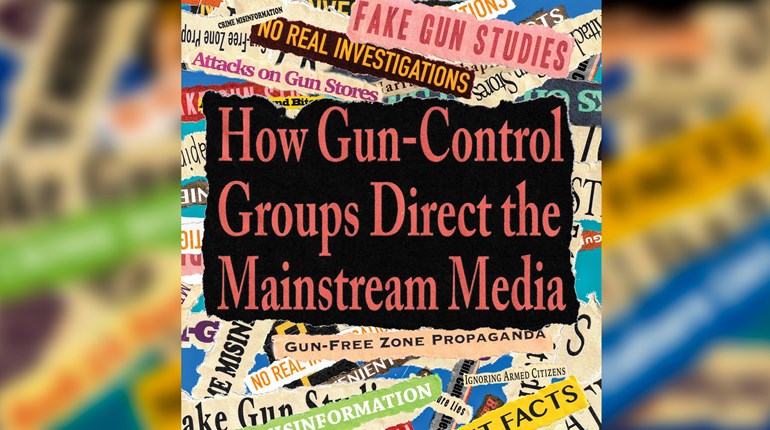
The Bloomberg School of Public Health at Johns Hopkins University launched a massive, open online course titled “Reducing Gun Violence in America: Evidence for Change.” The internet course is designed for high school and college students. The school has been in existence since 1916.
A lot of conservatives have warned that many American universities are morphing into de-facto indoctrination centers for progressive ideology. Still, Michael Bloomberg’s latest move is unapologetically partisan.
The Bloomberg School of Public Health at Johns Hopkins University has announced they are launching an open online course titled “Reducing Gun Violence in America: Evidence for Change.” The internet course is designed for high school and college students. Its intent is to turn them into anti-gun activists.
Michael Bloomberg (a 1964 graduate of the university) donated $300 million to Johns Hopkins in 2016 to have it carry out his agenda through the creation of a policy platform named the “Bloomberg American Health Initiative.”
Leading the new six-week online course is Dr. Cassandra Crifasi, co-director of the Johns Hopkins Center for Gun Policy and Research at the Bloomberg School of Public Health. She told NPR that the “hope is to get participants up to speed on relevant legal issues and effectively use data central to the nation’s policy debate on guns.”
She could have just said the hope is “indoctrinating young people.” That goal is better aligned with the course material which is actually presented. Crifasi said gun-rights organizations were intentionally not invited because the Bloomberg crew “didn’t want to have this be a debate of whether there’s an issue or not.”
Gun-rights groups may have been excluded because the Bloomberg crew had to deliver an advocacy program—not an education. Why else would they misrepresent laws, willfully ignore contradictory data, repeatedly cite preposterous research, describe the Bill of Rights as an “obstacle,” fantasize about nonexistent technology and offer clearly biased reviews of the body of research on firearm policy?
The first thing students of this course may notice is that there is apparently enough “gun-violence” research to fill out a 16-page course reference list. No pro-gun research made the cut—although several of the most high-profile, pro-gun studies were brought up only to be dismissed as “flawed.”
John Lott’s work on the impact of right-to-carry laws and mass shootings in gun-free zones is disparaged and dismissed—though reasons as to why his models are so “fatally flawed” are not offered.
Dr. Daniel Webster, a Bloomberg Professor of American Health and the Director of the Center for Gun Policy and Research, criticizes a Gary Kleck study that estimated about 2.5 million defensive gun uses per year. Also ignored was Kleck’s more recent analysis of long-lost Centers for Disease Control and Prevention (CDC) data that estimated 620,648 to 1.9 million defensive gun uses per year in a three-year period.
Webster offers no criticism of similar survey research with less pro-gun findings. He didn’t mention the number of defensive gun uses from these surveys. Instead, he said only that it found a “much, much smaller fraction of an estimated number of times in which civilians are using guns in self-defense.” That number was 116,000 per year, which is a significant number of Americans protecting themselves every year; especially when considering the percentage of the population that owns and carries a firearm.
John Lott’s work on the impact of right-to-carry laws and mass shootings in gun-free zones is disparaged and dismissed—though reasons as to why his models are so “fatally flawed” are not offered. An alternative definition for “gun-free zone” is presented and it would not list the White House as “gun-free zone.” Visitors to the White House are obviously prohibited from carrying a firearm.
The research that led to the prohibition of the CDC from engaging in anti-gun advocacy is referred to throughout the course and only limited criticism is offered. Arthur Kellerman’s 1993 “research” is presented as having found that “guns kept in the home are associated with an increase in the risk of homicide … .” Webster didn’t mention the more pressing risk factors Kellerman identified—likely because they are absurd: renting a home and living alone were both higher-risk factors than keeping a gun in the home. While he did mention two questions about Kellerman’s research, Webster failed to share with participants that Kellerman’s work excluded hundreds if not thousands of people from the study area who keep firearms in their home and were not murdered.
Studies designed to find a specific effect will find that effect. This is precisely the sort of one-sided presentation one should expect from advocates posing as researchers. Make no mistake about it: this online course is presented through the Bloomberg School of Public Health. The school’s logo is present before every video, and Dr. Webster sits in front of a Bloomberg School backdrop for panel discussions.
What may not be as expected is the deliberate exclusion of the Bloomberg School’s own research. Three high-ranking faculty members who led this online course were also all co-authors on a study published in Annals of Epidemiology in February that found no effect of California’s comprehensive background check and misdemeanor violence prohibition (for gun purchase and/or possession) on firearm homicides in the state. Participants in this online course would never know such evidence existed because the faculty of the Bloomberg School deliberately excluded it. Why? This study contradicts one of the policies they advocate throughout the program: prohibitions based on violent misdemeanors.
This is far from the only instance in which the presenters attempted to skew data to reach their desired result.
Because no studies have been conducted on the effect of permitless carry, Webster resorted to displaying data for a single state for just two years. He suggested that the policy caused the increase in firearms homicide rates. This simple “analysis” ignores other contributing factors in that state and ignores other states that have had permitless carry in effect for considerably longer with no negative results.
The Bloomberg faculty acknowledges that the evidence on the impact of “universal” background checks on gun homicides “has not found protective effects,” but they want them anyway. They also want waiting periods, which they know are useless—except as a move toward gun-owner licensing. Bloomberg’s advocates evangelize licensing, but their evidence is not what they claim. The Rand Corp., a nonprofit think tank, reviewed all firearms-related research published from 2003 to 2016, including much of the same research that Webster’s team presented as evidence that licensing will work. Rand found that licensing and permitting requirements have an uncertain effect on both total homicides and firearm homicides because the evidence is inconclusive.
The studies Webster referenced were the only studies reviewed by Rand on licensing. There were no other studies to conflict with or water down the results. But the Bloomberg School doesn’t care about that—they only care about pushing the next gun-control law.
Some presenters in this program lamented the protections afforded by the Bill of Rights. One of the presenters—in the context of reducing violence by targeting dangerous individuals—emphasized “all the hoops” required to have a person’s constitutional rights revoked. The “hoops,” of course, are due process.
But we can’t even be sure they truly understand the laws that exist. In a presentation on campus-carry laws, Dr. Alex McCourt claimed that states that allow both permitless carry and campus carry allow for the permitless carry of firearms on college campuses. That is incorrect. Some states with both policies require an enhanced permit to carry a concealed firearm on public campuses. McCourt also claimed that campus-carry states allow concealed firearms to be carried on all campuses within the state, but it is really limited to public colleges and universities. Private schools continue to set their own policies.
McCourt claimed in another presentation that “law enforcement has been hampered by its ability to trace crime guns and implement these policies [referring to the policies researchers supposedly would endorse if they had access to actual trace data].” None of that is true. Law enforcement still has access to trace data for investigations. The Bureau of Alcohol, Tobacco, Firearms and Explosives (ATF) supported this restriction—known as the Tiahrt Amendment—which restricts access to trace data to law enforcement and prosecutors. The only people hampered by it are anti-gun agitators who want to use it to harass legal businesses. Trace data does not necessarily reveal the name of the criminal who used a firearm.
Jon Vernick, a lawyer who assumed that no one at the NRA was qualified to comment on research, claimed that the firearms industry’s protection against frivolous lawsuits under the Protection of Lawful Commerce in Arms Act (PLCAA) is unlike anything else in the country; however, he failed to mention that no other industry faces the ire of opportunistic anti-gunners who seek to hold them responsible for the criminal misuse of their products. The outcome of the lawsuits doesn’t matter—it’s a war of financial attrition against firearms manufacturers and sellers.
Longtime anti-gunner Joshua Horwitz, of the Education Fund to Stop Gun Violence, delivers a presentation about microstamping, which he describes as a very promising, revolutionary technology to aid police investigations. Naturally, he failed to mention that existing technology could be readily circumvented by criminals and that the technology is different than what is mandated under California law.
It was supposed to be required beginning in 2010, but no firearms are manufactured with the required firing pin microstamping. It’s really an effort to ban semiautomatic handguns since the technology is impossible to implement.
Some presenters in this program lamented the protections afforded by the Bill of Rights. One of the presenters—in the context of reducing violence by targeting dangerous individuals—emphasized “all the hoops” required to have a person’s constitutional rights revoked. The “hoops,” of course, are due process.
The presenter supported expanding qualifying relationships for domestic-violence restraining orders and revoking Second Amendment rights based on ex-parte and emergency restraining orders. The subjects of such orders would have no opportunity to defend themselves in court before their rights are revoked. Depriving someone of their constitutional rights should not be an easy or convenient task—no matter how worthwhile the intended result may be. It seems as though the First, Fourth, Fifth and Sixth Amendments would be sacrificed alongside the Second Amendment.
There are some positive notes in the program. Webster acknowledged early on that “gun owners who purchase a firearm legally, generally speaking, are even more law-abiding than your average person.” That probably doesn’t mean Bloomberg will stop demonizing law-abiding gun owners for the actions of criminals, but it is something. Webster and his team also offered presentations on the concept of focused deterrence—a crime-fighting strategy that involves police identifying those likely to commit shootings (such as gang members) and making sure they know these high-risk people know there will be severe consequences for violence.
Programs, such as Cure Violence and Operation Ceasefire, have been successful in cities across the country. Other programs—including the National Shooting Sports Foundation’s Project Child Safe and gun-shop projects to promote suicide prevention—are working to reduce accidental fatalities and intentional self-harm.
A handful of positive acknowledgements did not change the nature of this online anti-gun program, nor did it provide an unbiased perspective. It offered only an artfully crafted anti-gun perspective masquerading as an educational course—along with biased research presented as science.
That’s the Bloomberg way. Remember that when they talk about “evidence-based” policies. The only evidence Bloomberg likes is anything that can be used as a rationale to take away your right to bear arms.


































